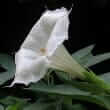Background
- Angel's trumpet is a common name for two closely related genera in the family Solanaceae: Brugmansia, comprising woody plants with pendulous flowers and Datura, comprising herbaceous plants with erect flowers. Some species formerly included in Datura are now classified in the separate genus Brugmansia.
- Angel's trumpet has a long history of use in native Central and South American cultures. There is archaeological evidence of the use of this herb for medicinal purposes in pre-Colombian times in northern Peru as far back as 1500 B.C. Use of angel's trumpet continues into contemporary times as Andean shamans ritually use the herb in healing rites and in order to diagnose disease.
- Parts of the angel's trumpet contain the poisonous belladonna alkaloids atropine, scopolamine, and hyoscyamine. In the 1990s and 2000s, the U.S. media reported stories of adolescents and young adults dying or becoming seriously ill from intentionally ingesting angel's trumpet. Because of the high potential for overdose and accounts indicating the rising rates of this herb as a hallucinogen by teenagers in the United States, medicinal uses are often discouraged. Angel's trumpet is considered poisonous and it is on the U.S. Food and Drug Administration's (FDA) Poisonous Plants List.
References
Natural Standard developed the above evidence-based information based on a thorough systematic review of the available scientific articles. For comprehensive information about alternative and complementary therapies on the professional level, go to . Selected references are listed below.
- Carod-Artal, FJ and Vazquez-Cabrera, CB. [Mescaline and the San Pedro cactus ritual: archaeological and ethnographic evidence in northern Peru]. Rev Neurol 4-16-2006;42(8):489-498.
View Abstract - De, Feo, V. Ethnomedical field study in northern Peruvian Andes with particular reference to divination practices. J Ethnopharmacol 2003;85(2-3):243-256.
View Abstract - Francis, PD and Clarke, CF. Angel trumpet lily poisoning in five adolescents: clinical findings and management. J Paediatr Child Health 1999;35(1):93-95.
View Abstract - Gopel, C, Laufer, C, and Marcus, A. Three cases of angel's trumpet tea-induced psychosis in adolescent substance abusers. Nord.J.Psychiatry 2002;56(1):49-52.
View Abstract - Hall, RC, Popkin, MK, and McHenry, LE. Angel's Trumpet psychosis: a central nervous system anticholinergic syndrome. Am J Psychiatry 1977;134(3):312-314.
View Abstract - Havelius, U and Asman, P. Accidental mydriasis from exposure to Angel's trumpet (Datura suaveolens). Acta Ophthalmol Scand 2002;80(3):332-335.
View Abstract - Isbister, GK, Oakley, P, Dawson, AH, et al. Presumed Angel's trumpet (Brugmansia) poisoning: clinical effects and epidemiology. Emerg Med (Fremantle.) 2003;15(4):376-382.
View Abstract - Marneros, A, Gutmann, P, and Uhlmann, F. Self-amputation of penis and tongue after use of Angel's Trumpet. Eur Arch Psychiatry Clin Neurosci 2006;256(7):458-459.
View Abstract - McHenry, LE and Hall, RC. Angel's trumpet. Lethal and psychogenic aspects. J Fla Med Assoc 1978;65(3):192-196.
View Abstract - Mobus, U, Demmler, G, and Schulz, K. [Accidental drowning due to tropane alkaloid abuse]. Arch Kriminol 2002;210(1-2):16-21.
View Abstract - Nencini, C, Cavallo, F, Bruni, G, et al. Affinity of Iresine herbstii and Brugmansia arborea extracts on different cerebral receptors. J Ethnopharmacol 5-24-2006;105(3):352-357.
View Abstract - Niess, C, Schnabel, A, and Kauert, G. [Angel trumpet: a poisonous garden plant as a new addictive drug?]. Dtsch Med Wochenschr 12-3-1999;124(48):1444-1447.
View Abstract - Paetzold, W, Schneider, U, Emrich, HM, et al. [Angel trumpets: case report of drug-induced psychosis caused by Brugmansia insigniis]. Psychiatr Prax 1999;26(3):147-148.
View Abstract - Van, der Donck, I, Mulliez, E, and Blanckaert, J. Angel's trumpet (Brugmansia arborea) and mydriasis in a child--a case report. Bull Soc Belge Ophtalmol 2004;(292):53-56.
View Abstract







